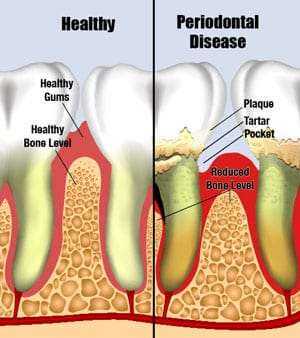Controlling plaque is key to fighting both tooth decay and gum disease. Plaque is the film that builds up on teeth over time. It consists of food particles mixed with saliva and is loaded with bacteria. If you fail to brush your teeth regularly, the plaque on your teeth will become hardened by the calcium and other minerals in your saliva to form a substance called tartar. Tartar is porous, so it is easily stained; tartar causes yellowed teeth and can also result in bad breath.
Plaque and Tooth Decay
The bacteria contained in plaque feed on the carbohydrates and sugar in food. These bacteria convert the carbohydrates and sugar into acid, which is held against the tooth by the plaque. Eventually, the acids dissolve the tooth enamel and cause decay. Tooth decay may be painless in its early stages but if the plaque is not removed, the tooth will rot all the way down to the nerves or the pulp.
Plaque and Gum Disease
When plaque and tartar are allowed to remain on teeth, they irritate the gingiva. The gingiva is the part of the gums around the base of the teeth. This irritation is called gingivitis and causes the gums to become swollen and to bleed easily. Gingivitis can lead to gum disease, also known as periodontitis. Gum disease is the inflammation or infection of the bone below the gums. The disease causes the gums to recede away from the teeth and form pockets that collect plaque and bacteria. The resulting bone loss may eventually cause the teeth to start falling out.
Common Causes of Plaque Buildup and Gum Disease
Factors that encourage gum disease include:
- Poor dental hygiene.
- Tobacco use in the form of smoking and chewing tobacco can keep gum tissue from healing.
- Crooked or misaligned teeth are more difficult to clean thoroughly and therefore may allow for plaque buildup.
- Diets that are high in carbohydrates and sugar or low in nutrients like vitamin C can create the perfect conditions for plaque and gum disease.
How Plaque is Removed
Tartar is difficult to remove by brushing alone. Fortunately, dental professionals like Kristen Ritzau, DDS have the tools and skills needed to do the job. The process involves using ultrasonic tools to knock the tartar loose then finishing up with hand tools like scalers and curettes to scrape away the remaining deposits. In order to preserve your teeth, make sure to get routine dental check-ups and practice good oral hygiene to slow or prevent the buildup of tartar.


